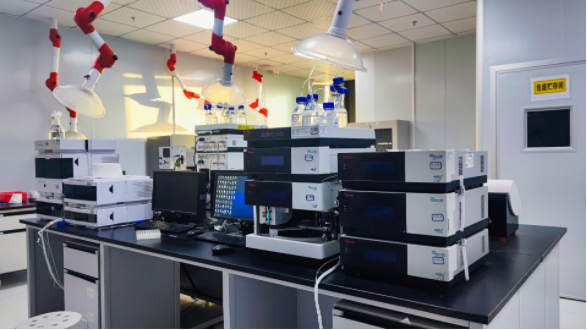
01 Jan
A Promising Intestinal Health Protector: NMN

1. Introduction
Nicotinamide Mononucleotide (NMN) has been deemed as a functional nutrient for improving human intestinal health. In this study, an in vitro simulated digestion model is established under salivary and gastrointestinal conditions to determine the digestive properties of NMN, followed by the track of subsequent fermentation and its effect on the intestinal microbiota.


2. The digestion and fermentation of NMN
No significant change is discernible in the molecular weight of NMN under salivary and gastrointestinal conditions. The hydrolysis rates of NMN to nicotinamide (NAM) in saliva, gastric juice and intestinal fluid are 3.0%, 1.9% and 4.2%, respectively, signifying that NMN can reach the colon without apparent difficulty.

Post 24-h fermentation, NMN boosts the accumulation of propionate and butyrate by 88 % and 23 %, respectively, enhancing the abundance of beneficial genera (Bifidobacterium, Phascolarctobacterium, Faecalibacterium and Alistipes) and repressing proliferation of some harmful bacteria (Sutterella, Desulfovibrio and Pseudomonas) in human intestinal microbiota.


Post 24-h fermentation, NMN boosts the accumulation of propionate and butyrate by 88 % and 23 %, respectively, enhancing the abundance of beneficial genera (Bifidobacterium, Phascolarctobacterium, Faecalibacterium and Alistipes) and repressing proliferation of some harmful bacteria (Sutterella, Desulfovibrio and Pseudomonas) in human intestinal microbiota.

3. The intestine metabolic pathway of NMN
Prior to being absorbed by the human body, NMN should be first transformed into nicotinamide ribose (NR), then degraded to NAM and converted to niacinate (NA). Concretely, intestinal microbiome degraded into various fermentation products such as NR, NAM, NA, etc., which are absorbed and utilized as nutrients by the intestinal microbiome.


4. The role of SCFAs in intestinal tract
Short-chain fatty acids (SCFAs), such as acetate, propionate, and butyrate, are the major products of carbohydrate fermentation in the colon, which can maintain normal gut function, bolster the absorption of sodium and calcium, promote digestion, facilitate the healing of injured intestinal mucosa, and prevent ulcers and enteritis.
5. The relationship between NMN, intestinal microbiota, and SCFAs
NMN and its catabolism intermediates function as a carbon source for the proliferation of intestinal microbes during the in vitro NMN fermentation by human intestinal microbes. The low level of branched SCFAs in the NMN group is due to the breakdown of NMN by microorganisms into a variety of carbohydrates, including NAM and ribose.


6. Conclusion
In addition to modulating the fermentation metabolites, NMN can regulate microbiota composition by promoting the proliferation of beneficial genera, providing a potent guarantee and support for intestinal health.
Reference
Tang Z, Bao P, Ling X, Qiu Z, Zhang B, Hao T. In vitro digestion under simulated saliva, gastric and small intestinal conditions and fermentation of nicotinamide mononucleotide, and its effects on the gut microbiota. Food Res Int. 2024;177:113779. doi:10.1016/j.foodres.2023.113779
About BONTAC
BONTAC has dedicated to the R&D, manufacture and sale of raw materials for coenzyme and natural products since 2012, with self-owned factories, over 160 global patents as well as strong R&D team consisting of Doctors and Masters.

BONTAC has rich R&D experience and advanced technology in the biosynthesis of NMN. High quality and stable supply of products can be better ensured here with the exclusive Bonpure seven-step purification technology and Bonzyme Whole-enzymatic method.

BONTAC has rich R&D experience and advanced technology in the biosynthesis of NMN. High quality and stable supply of products can be better ensured here with the exclusive Bonpure seven-step purification technology and Bonzyme Whole-enzymatic method.
Disclaimer
This article is based on the reference in the academic journal. The relevant information is provide for sharing and learning purposes only, and does not represent any medical advice purposes. If there is any infringement, please contact the author for deletion. The views expressed in this article do not represent the position of BONTAC.
Under no circumstances will BONTAC be held responsible or liable in any way for any claims, damages, losses, expenses, costs or liabilities whatsoever (including, without limitation, any direct or indirect damages for loss of profits, business interruption or loss of information) resulting or arising directly or indirectly from your reliance on the information and material on this website.
Under no circumstances will BONTAC be held responsible or liable in any way for any claims, damages, losses, expenses, costs or liabilities whatsoever (including, without limitation, any direct or indirect damages for loss of profits, business interruption or loss of information) resulting or arising directly or indirectly from your reliance on the information and material on this website.
